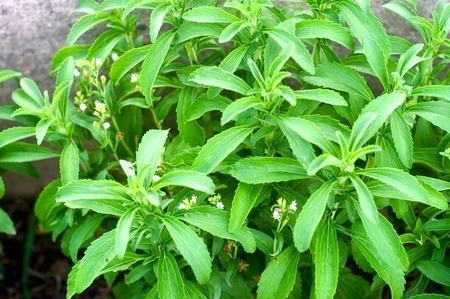
Stevia (collectively the steviol glycosides), is now permitted for use as a sweetener in a host of products as in table-top products within the EU. One of the difficulties is the measurement of the components that constitute it. In Stevia’s case, sweetness depends on the quality of individual componentry and the presence of competing and off-flavour causing chemicals as part of the mix (Higginbotham, 1983). Rebaudioside A is nearly 500 times sweeter than sucrose whereas rebaudioside C is only 120 times sweeter. Maximising the Reb. A content is paramount but can be expensive to achieve. Stevioside and other related components however contribute liquorice and an unpleasant bitterness if too prominent in the mix. It is critical to achieve a proper characterisation of Stevia leaf preparations to obtain an appropriate balance of rebaudioside components and minimise the off-flavour derivatives. JECFA have also generated technical, safety and purity specifications for various grades of Stevia extract. There is also a strong commercial need to characterise preparations which are available for quality control and to minimise the impact of adulteration.
Measurement of steviol and its myriad glycosides is being tackled comprehensively. A typical analysis may involve up to 10 different steviol glycosides (Geuns, 2010). So far, JECFA have a validated analytical method based on RP-HPLC (reverse phase high performance liquid chromatography ) with UV detection (JECFA, 2010). Leaf extracts also contain a number of other matrix components which must also be considered. Likewise, Stevia may be part of a matrix to which it is added such as a beverage and which contributes competing substances (Amery et al., 2010; 2011). Extraction methods from the leaf, both living and dried have been sought (Kolb et al., 2001).
In early analytical studies, HPLC was compared with capillary electrophoresis (Liu and Li, 1995) to establish the most appropriate way forward, and both were found to be suited to the task. Other methods for characterising Stevia materials have tested thin layer chromatography (Jaitak et al., 2008) or applied two-dimensional liquid chromatography (LC x LC) with electrospray ionisation time-of-flight spectrometry (ESI-TOF-MS) (Pól et al., 2007). Liquid chromatography has been developed using a variety of stationary phases with NH2 (Liu and Li, 1995; Kolb et al., 2001).
HPLC and uHPLC (ultra) remains the method of choice. Lately, uHPLC coupled to mass spectrometry (MS) has been used to quantify steviol and the glycosides (Gardana et al., 2010). Stevia and its degradation products have been assessed in model beverages using both HPLC with UV detection, and with LC-ESI-MS (Wölwer-Rieck et al., 2010). An application using near infrared reflectance spectroscopy (NIRS) is reported (Hearn and Subedi, 2009). A quantitative NMR method has been devised which is claimed to be as effective as the HPLC devised by JECFA but even quicker, and without the need for standards or separation of the componentry in question. It is too early to say if there will be widespread adoption of the method (Pieri et al., 2011). One group reports using square-wave polarography to measure steviol concentrations between 10 and 35 µmoles/l in the leaf itself suggesting it has commercial potential (Komorsky-Lovric et al., 2010).
References
Amery, R., Jooken, E., Duquenne, B., Geuns, J., Meesschaert, B., (2010). Determination of Steviol Glycosides in Various Dairy Matrices and Soy Drink. In: Geuns, J. (Ed.), Proceedings of the 4th Stevia Symposium 2010 organized by EUSTAS: Stevia: Science, no fiction. Euprint, Leuven, pp. 69-81
_______., Struyf, T., Duquenne, B., Jooken, E., Geuns, J. Meesschaert, B. (2011) Determination of Steviol Glycosides in Various Food Categories. In: Geuns, J. (Ed.), Proceedings of the 5th Stevia Symposium 2011 organized by EUSTAS: Stevia: Break-through In Europe. Euprint, Leuven. Chapt. 12. Pp. 153- 164
Gardana, C., Scaglianti, M., Simonetti, P., 2010. Evaluation of steviol and its glycosides in Stevia rebaudiana leaves and commercial sweetener by ultrahigh-performance liquid chromatography-mass spectrometry. J. Chromatography A 1217, pp. 1463-1470.
Geuns, J. M. C., Struyf, T., 2009. EUSTAS round robin testing of Steviol Glycosides. In: Geuns, J. M. C. (Ed.), Proceedings of the 3rd Stevia Symposium 2009 Euprint, Leuven, pp. 35 – 48.
Hearn, L.K. and Subedi, P.P. (2009) Determining levels of steviol glycosides in the leaves of Stevia rebaudiana by near infrared reflectance spectroscopy. J. Food Composition and Anal. 22 pp. 165–168.
Higginbotham, J.D. 1983. Recent developments in non-nutritive sweeteners. In: Progress in Sweeteners (T.H. Grenby, K.J. Parker and M.G. Lindley, eds.) pp. 119–155, Applied Science Publishers, London, U.K.
Jaitak, V., Gupta, A. P., Kaul, V. K., Ahuja, P. S., 2008. Validated highperformance thin-layer chromatography method for steviol glycosides in Stevia rebaudiana. J. Pharmaceut. Biomedical Analysis 47, pp. 790-794.
Joint FAO/WHO Expert Committee on Food Additives (JECFA, 2010), Compendium of Food Additive Specifications. Monograph 10. Steviol glycosides. Available at:
http://www.fao.org/ag/agn/jecfa-additives/specs/monograph10/additive-442-m10.pdf (accessed February 2012)
Kolb, N., Herrera, J.L., Ferreyra, D.J., Uliana, R.F. (2001) Analysis of Sweet Diterpene Glycosides from Stevia rebaudiana: Improved HPLC Method. J. Agric. Food Chem., 49 (10) pp. 4538-4541
Komorsky-Lovric, S., Novak, I., Novak, B. (2010) Measurement of Stevioside by Square-Wave Polarography. Electroanalysis. 22(19) pp. 2211-2215.
Liu, J., Li, S. F. Y. (1995) Separation and determination of stevia sweeteners by capillary electrophoresis and high performance liquid chromatography. J. Liq. Chromatogr., 18 pp. 1703-1719.
Pieri, V., Belancic, A., Morales, S., Stuppner, H. (2011) Identification and Quantification of Major Steviol Glycosides in Stevia rebaudiana Purified Extracts by 1H NMR Spectroscopy. J. Agric. Food Chem., 59(9) pp. 4378-4384
Pól, J., Hohnová, B., Hyötyläinen, T. (2007) Characterisation of Stevia Rebaudiana by comprehensive two-dimensionalliquid chromatography time-of-flight mass spectrometry. J. Chromatogr. A 1150 pp. 85-92
Wölwer-Rieck, U., Tomberg, W., & Wawrzun, A. (2010). Investigations on the Stability of Stevioside and Rebaudioside A in Soft Drinks. J. Agric. Food Chem., 58(23), pp. 12216-12220.

hi
thanks for your text.
i need standard method of analyse Steviol Glycosides in beverage .in fact find Steviol Glycosides in beverage and meusture it in drink.please help me.
thank you
Hello,
You can contact me for more details about the analysis, or we can anlalyze some samples for you.
E. Jooken